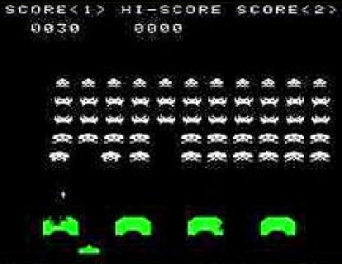
review book
supercade, a visual history of the videogame age, 1974 - 1981
review by Gregory Little
download pdf
 |
intelligent
agent vol. 3 no. 1
review book supercade, a visual history of the videogame age, 1974 - 1981 review by Gregory Little download pdf |
 a visual history of the videogame age, 1974 - 1981 by Van Burnham (MIT Press, 2001) review by Gregory Little |
book |
Van Burnham's Supercade is a beautifully designed book documenting the visual history of the classical period of the videogame age. Burnham's Wired™ style, montage-based, McLuhanesque design offers a rich visual chronology of the gaming culture that includes interviews with and essays by the leading developers and entrepreneurs of the gaming industry. Burnham constructs congruent "levels" within the chronology - rows, columns, and overlays that address related issues ranging from Peter Samson's "Dictionary of the TMRC Language" (TMRC stands for "The Midnight Requisitioning Committee" aka "The Model Railroad Club," the student club of hackers from MIT that developed Spacewar! in 1961), to "A Brief Retrospective of violence, censorship, and controversy in the videogame age . . ." These levels punctuate and enhance the flow of technical development, product releases, and innovation. Dramatic full color bleeds, and sumptuous zoomed-in screen captures span across pages, woven with vintage illustrations from original advertisements, packaging designs, photographs of original developers, and schematic diagrams and close-ups of circuits. As important as the documentary reportage of the history of this entertainment idiom is the conceptual merger of book design and an emergent gaming aesthetic. The design motifs shift as the gaming styles evolve, as fonts, color, and resolution often reflect the game and time period described. I found an elegant beauty in the vector graphics and indexed line sets of Tempest and Battlezone, and let a sigh of relief when gazing at Intellivision's and Stargate's unselfconscious display of raw pixels and aliased edges of 8-bit color. Culling through the interviews reveals some important events in digital culture not directly included in Burnham's timeline; for example, Steven Johnson's account of Mattel Electronics Intellivision in 1978 reveals the unintentional introduction of the concept of "vaporware;" and later the April 3rd, 1982, death of Peter Bukowski, age 18, of a heart attack while playing Berzerk in the River Oaks Shopping Center in Calumet City, Illinois.

In a predictably techno-determinist fashion, Burnham
does see the historical significance of the videogame
culture of 1982 as marking the point in history where we
shifted from an analog society to a digital one, and is
quite utopian in her description:
" . . . . prepared us to move forward from the static
realm of Parcheesi, pneumatic tubes, and push buttons
into today's dynamic internet economy saturated
with interactive entertainment, ATMs, and
digitally enhanced interfaces to control our
every whim and desire . . . . . all from the comfort
of our… . .home computers."
Burnham and other advocates and developers
of interactive entertainment frequently claim
that the videogame represents a higher level of
entertainment that empowers the individual:
"Before video games were created,
popular entertainment consisted of radio, film,
and television, all passive forms of entertainment.
This technology marked the first time in
history when mainstream America was able to
actually use technology in a new way."
(from email Burnham to Brad King,
Wired News)
This argument is again a recursive one
because it looks at technological
development from the point of
view of the machine, not the
individual. Ms. Burnham
chose not to include in her
timeline the 1982 article
"Surgeon General Sees
Danger in Video Games,"
New York Times, November
10. Prior to 1984, many
essays, studies, tests, and
books cast both negative and positive lenses
on video games and learning, gender, play, violence,
development, and family interaction.
Although there are many studies that find direct
correlations between violent, aggressive behaviors
and video game use (for example, Ross
and Ross, 1961), there are some that do not
(most notably, Kestenbaum and Weinstein,
1985). It is safe to say that initial pre-conditions
present in the individual are a significant determining
factor in the effects of videogame playing.
The individual, especially the child, is primarily
involved in an experience of learning through
play. The real issue then is the nature of this
form of play and what is being taught. The
main operatives of the majority of video games
is violence (Provenzo, 1991), xenophobia (starting
in 1961 with Spacewars!) and a Freudian
focus on oral fantasies of engulfment, of "eat or
be eaten," as in Pac-Man, BurgerTime, and
Jaws (Klein, 1984). In addition, gamers are
often physically inert for hours, representing a
new Foucaultesque cult of docile bodies waiting
for colonization. Many argue the catharsis
point of view: that we adults are afraid of the violence in these
games, but from the child's point of view, important conflicts, fears,
anxieties, and aggressions can be played out and resolved in the
safe Supercade of the videogame. Certainly this is the case for
many players, but the research holds that a statistically significant
number of players do exhibit greater agression after playing the
games (Dominick, 1984; Anderson and Ford, 1986; Graybill,
1985).
As Montaigne, Bettelheim, Turkle and others have noted, a developing person's play is probably their most serious activity, revealing self-image, extending the social self, and forming a bridge between childhood and adult realities. Our technologies are not neutral (see Bowers 1980; Postman 1992). Technology mediates our understanding of culture, society, family values, and capital. Videogames are powerful teaching tools at fundamental levels of personality development. When compared to a child's pretend games and free-form make believe, the videogame is an impoverished form of play; overly determined, unimaginative, and forcing children to follow closed external systems of programming logic. Videogame play lacks a critical element - the player's ability to define, and change the conditions of the play itself (Turkle, 1982).
a developing person's play is probably |
With the release of the VIC-20 in 1981, the players can copy software (phase one of hacking), but the game developer and manufacturer strictly define the architecture of play. The developer's bottom line is not enhanced levels of play encouraging the healthy development of young egos, but sales. The player is not permitted to make decisions for herself, and there is almost no degree of independence, no reward for intuition, creativity, experimentation, or free play. The child is intensely focused on the gaming experience, and therefore not able to contemplate inner dialogues or formulate internal catharsis. So, what is really being taught? I am convinced, especially after looking at Supercade, that aesthetics is both the medium and the message.

"We will glorify war-the only true hygiene of the world--militarism,
patriotism, the destructive gesture . . . the beautiful ideas
which will kill, and the scorn of women. . . . for Art can only be violence,
cruelty, and injustice."
Like the videogame era, "The Foundation and Manifesto
of Futurism" worships youth culture and purports that
anyone over 30 can play no active part. Like many of the
most popular videogames, the Futurist's "Manifesto"
advocates a state of anarchy, but the Futurists were actually
not anarchists but staunch Nationalists who, after
WW I, succeeded in making Futurism the official art of
the Italian Fascist Movement. Supercade makes it very
clear to me that a gaming aesthetic is really an aesthetics
of war. For example, Ms. Burnham starts Supercade with
an objective account of the somewhat chilling development
of the first videogame at the Brookhaven National
Laboratory in 1958. Tennis for Two roots the videogame
in the 1950's cold war age of nuclear proliferation,
McCarthyism, Nationalism, the explosion of capitalism,
and paranoia. The ironic intent of Tennis for Two, to
entertain visitors to BNL, would serve to distract the public
by channeling their atomic anxieties into a simple competitive
context.
Tennis for Two is clearly a trope for the cold war, as two opposing sides serve up and volley a glowing co(ordinate) representing the technological innovation of nuclear proliferation and the space race. A modernist reduction of cold war US/Soviet relations, this prototypical game roots the genre in the aesthetics of war. It is possible that the message being delivered by the majority of videogames is nothing less than a world view, one that indoctrinates with a Darwinist conformity that the bottom line of both war and capitalism, PacMan's eat or be eaten, is actually the reality of life on earth, the code by which we should live by. A look at the history of Art can offer us an alternative world view. I think a logical alternative in a search for a different gaming aesthetic would be to look to the ultimate gamer/artist, Marcel Duchamp. For Duchamp, who stopped making art early in his career to devote himself to playing chess, gaming was not winning or losing, but about "our urge for understanding," "the structures of chance," "like designing or constructing a mechanism," and "the competitive side of it has no importance" (Duchamp, Criticavit). Duchamp's world view was one of free play, word games, visual and intellectual puns. Maybe his game-boy sized, "Echiquier de Poche" (Pocket Game) of 1942 is worth a closer look. Indeed, the recent advent of level or mod developments, and the inclusion of open game engines into their products by companies like Epic Games open the possibility for the end user creation of completely unique gaming architectures and a level of independence and free play. Recent artworks like John Klima's JackandJill.exe, and the recent feminist hacker plugins and patches as outlined in Anne-Marie Schleiner's "Does Lara Croft wear fake Polygons?" confirm that many are implementing alternative world views.
Van Burnham's Supercade pays necessary tribute to the techology, games, and visionaries behind this multi-billion dollar industry. It documents aspects of the history of this industry beautifully and with accuracy, and is an important document that begs for future, alternative, critical research and development. "No, the question is: in the future what won't be like a videogame?" (Craig Kanarick, co-founder of Razorfish, from Supercade, page 417)
Looking at the videogame age through the lenses of aesthetics and play both defines and gives us a choice in what the videogame and the videogamer will look like in the future. Baudelaire wrote of the child's desire "to get at and see the soul of their toys." In a search for guides in this regard, I prefer Duchamp.